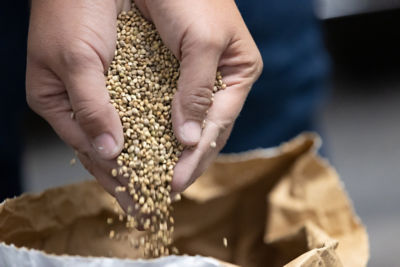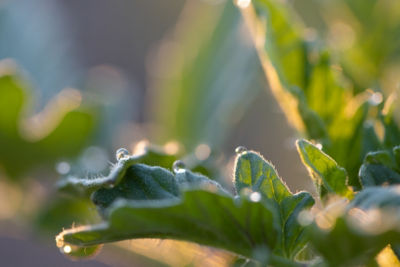Click here to download a PDF version of this spotlight
» Gummy stem blight can cause substantial damage to watermelon growing in warm and humid regions.
» The fungi that cause gummy stem blight can survive on infested crop debris and susceptible weed species.
» Gummy stem blight is managed primarily through applications of fungicides.
Gummy stem blight is one of the most destructive diseases of watermelon in tropical and subtropical regions, such as the southeastern U.S.1 The average yield loss from this disease in non-treated plantings has been reported as 43%, and gummy stem blight was the most common disease of watermelon in South Carolina between 2015 and 2017.2,3
SYMPTOMS
Infections by the gummy stem blight pathogens can occur at any growth stage of the plant.4 Symptoms on watermelon leaves show up as circular to triangular, dark brown spots that usually appear first near the leaf margins (Figure 1A). Spots often develop first on the leaves that are shaded or stay moist for long periods. The spots can enlarge and coalesce until the entire leaf becomes blighted. The tissue in the center of the spots can crack and fall out (Figure 1B). Gummy stem blight also occurs on seedlings, where spots form on cotyledons and true leaves. Water-soaked areas can form on the cotyledons as the brown spots develop. If the hypocotyl of the seedling is colonized and girdled, seedlings can wilt and die.1,4
 Figure 1. Foliar symptoms of gummy stem blight on watermelon. (A) Initial symptom of a brown, necrotic lesion near the leaf margin. (B) With time, the center tissue can crack and fall out of the lesion. Gerald Holmes, Strawberry Center, Cal Poly San Luis Obispo, Bugwood.org.
Figure 1. Foliar symptoms of gummy stem blight on watermelon. (A) Initial symptom of a brown, necrotic lesion near the leaf margin. (B) With time, the center tissue can crack and fall out of the lesion. Gerald Holmes, Strawberry Center, Cal Poly San Luis Obispo, Bugwood.org.
The name gummy stem blight comes from the amber to reddish-brown exudate (ooze) that forms on the stem cankers (lesions) (Figure 2). Stem infections do not normally kill older plants, but affected vines can wilt in the late disease stages, three to four weeks after infection, usually after fruit set.1,4
 Figure 2. Gummy exudate on a stem canker. Rebecca A. Melanson, Mississippi State University Extension, Bugwood.org.
Figure 2. Gummy exudate on a stem canker. Rebecca A. Melanson, Mississippi State University Extension, Bugwood.org.
The fruit rot phase of the disease (also called black rot) typically only occurs when the vines are severely infected.5,6 Circular, greasy, greenish-tan to black spots develop initially on the blossom end of the fruit. Fruit lesions are sunken in the center and coalesce as they expand. The internal rind tissue turns dark brown to black and can become cracked.4,5 Black specks develop in the necrotic tissue of leaf, stem and fruit lesions (Figure 3). These black specks are the sexual and asexual spore producing structures of the fungus that produce sexual ascospores and asexual spores called conidia.1,4
 Figure 3. Black fruiting bodies of the fungus form in the necrotic tissues of leaf, stem, and fruit lesions.
Figure 3. Black fruiting bodies of the fungus form in the necrotic tissues of leaf, stem, and fruit lesions.
PATHOGENS AND DISEASE CYCLE
Gummy stem blight affects many cucurbit crops, including watermelon, melon, cucumber, pumpkin, and squash. Non-cucurbit hosts include green bean, okra, tomato, and tobacco. The disease is caused by the fungi Stagonosporopsis citrulli, S. cucurbitacearum, and S. caricae. Stagonosporopsis cucurbitacearum can only infect cucurbit plants and is the species most commonly found on cucurbit crops.1 However, S. citrulli was most commonly isolated species from watermelon in South Carolina between 2015 and 2017 and is the dominant species on cucurbits in the southeastern U.S.3
The gummy stem blight fungi survive (overwinter) on infested crop debris, volunteer plants, and susceptible weed species. The pathogens can remain viable on infested debris for several years. The pathogens can also survive on infected seed.1,6 Gummy stem blight has a polycyclic cycle with plant to plant spread during the season. The pathogen is spread long distances on seed and by wind-dispersed ascospores. Shortdistance disease spread occurs by splashing water (rain or overhead irrigation) moving the conidia to nearby plants.4,7
Gummy stem blight is favored by warm temperatures and wet conditions. Infection occurs at temperatures from 60° to 82°F (16° to 28°C) with an optimum temperature range of 75° to 77°F (24° to 25°C). The optimum temperature for sporulation of the pathogen is 77°F (25°C).1,4,7
Infection, disease development, and spread are substantially affected by moisture conditions. High humidity levels (>85%) and one to ten hours of continuous leaf wetness are needed for infection to occur. Further periods of wetness are needed for the development of lesions. Rainfall, overhead irrigation, and poor drainage can increase disease spread, infection, and symptom development. Symptoms typically appear seven to twelve days after infection.1,4,7 Wounding from mechanical injury, insect feeding, and other diseases can provide sites for infection. Harvest scars on the fruit also can serve as sites of infection leading to post-harvest decay.4
MANAGEMENT
Gummy Stem Blight of Watermelon
Click here to download a PDF version of this spotlight.
» Gummy stem blight can cause substantial damage to watermelon growing in warm and humid regions.
» The fungi that cause gummy stem blight can survive on infested crop debris and susceptible weed species.
» Gummy stem blight is managed primarily through applications of fungicides.
Gummy stem blight is one of the most destructive diseases of watermelon in tropical and subtropical regions, such as the southeastern U.S.1 The average yield loss from this disease in non-treated plantings has been reported as 43%, and gummy stem blight was the most common disease of watermelon in South Carolina between 2015 and 2017.2,3
SYMPTOMS
Infections by the gummy stem blight pathogens can occur at any growth stage of the plant.4 Symptoms on watermelon leaves show up as circular to triangular, dark brown spots that usually appear first near the leaf margins (Figure 1A). Spots often develop first on the leaves that are shaded or stay moist for long periods. The spots can enlarge and coalesce until the entire leaf becomes blighted. The tissue in the center of the spots can crack and fall out (Figure 1B). Gummy stem blight also occurs on seedlings, where spots form on cotyledons and true leaves. Water-soaked areas can form on the cotyledons as the brown spots develop. If the hypocotyl of the seedling is colonized and girdled, seedlings can wilt and die.1,4
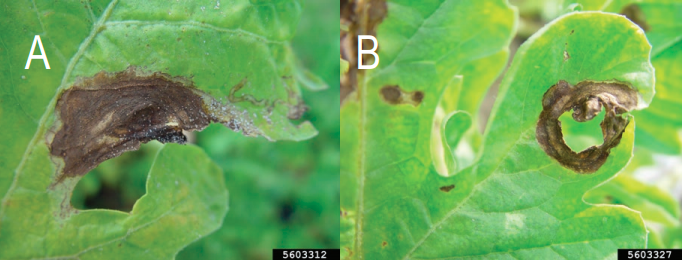
Figure 1. Foliar symptoms of gummy stem blight on watermelon. (A) Initial symptom of a brown, necrotic lesion near the leaf margin. (B) With time, the center tissue can crack and fall out of the lesion. Gerald Holmes, Strawberry Center, Cal Poly San Luis Obispo, Bugwood.org.
The name gummy stem blight comes from the amber to reddish-brown exudate (ooze) that forms on the stem cankers (lesions) (Figure 2). Stem infections do not normally kill older plants, but affected vines can wilt in the late disease stages, three to four weeks after infection, usually after fruit set.1,4
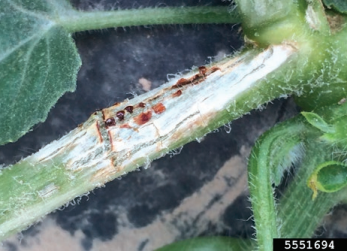
Figure 2. Gummy exudate on a stem canker. Rebecca A. Melanson, Mississippi State University Extension, Bugwood.org.
The fruit rot phase of the disease (also called black rot) typically only occurs when the vines are severely infected.5,6 Circular, greasy, greenish-tan to black spots develop initially on the blossom end of the fruit. Fruit lesions are sunken in the center and coalesce as they expand. The internal rind tissue turns dark brown to black and can become cracked.4,5 Black specks develop in the necrotic tissue of leaf, stem and fruit lesions (Figure 3). These black specks are the sexual and asexual spore producing structures of the fungus that produce sexual ascospores and asexual spores called conidia.1,4
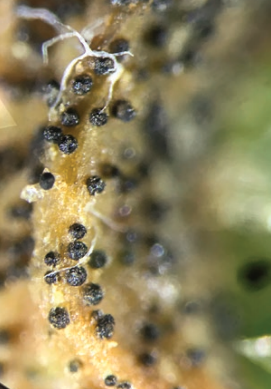
Figure 3. Black fruiting bodies of the fungus form in the necrotic tissues of leaf, stem, and fruit lesions.
PATHOGENS AND DISEASE CYCLE
Gummy stem blight affects many cucurbit crops, including watermelon, melon, cucumber, pumpkin, and squash. Non-cucurbit hosts include green bean, okra, tomato, and tobacco. The disease is caused by the fungi Stagonosporopsis citrulli, S. cucurbitacearum, and S. caricae. Stagonosporopsis cucurbitacearum can only infect cucurbit plants and is the species most commonly found on cucurbit crops.1 However, S. citrulli was most commonly isolated species from watermelon in South Carolina between 2015 and 2017 and is the dominant species on cucurbits in the southeastern U.S.3
The gummy stem blight fungi survive (overwinter) on infested crop debris, volunteer plants, and susceptible weed species. The pathogens can remain viable on infested debris for several years. The pathogens can also survive on infected seed.1,6 Gummy stem blight has a polycyclic cycle with plant to plant spread during the season. The pathogen is spread long distances on seed and by wind-dispersed ascospores. Shortdistance disease spread occurs by splashing water (rain or overhead irrigation) moving the conidia to nearby plants.4,7
Gummy stem blight is favored by warm temperatures and wet conditions. Infection occurs at temperatures from 60° to 82°F (16° to 28°C) with an optimum temperature range of 75° to 77°F (24° to 25°C). The optimum temperature for sporulation of the pathogen is 77°F (25°C).1,4,7
Infection, disease development, and spread are substantially affected by moisture conditions. High humidity levels (>85%) and one to ten hours of continuous leaf wetness are needed for infection to occur. Further periods of wetness are needed for the development of lesions. Rainfall, overhead irrigation, and poor drainage can increase disease spread, infection, and symptom development. Symptoms typically appear seven to twelve days after infection.1,4,7 Wounding from mechanical injury, insect feeding, and other diseases can provide sites for infection. Harvest scars on the fruit also can serve as sites of infection leading to post-harvest decay.4
MANAGEMENT
Infected seeds and transplants can be a source of gummy stem blight, so purchasing seeds and seedlings from a reputable dealer is important. Seed treatment fungicides may also help prevent the introduction of the disease.4,7 Seedlings should be inspected for symptoms of gummy stem blight before transplanting. Trays of transplants containing any infected seedlings should be discarded.
Crop debris should be plowed in promptly after harvest, and a two- to four-year rotation to non-host crops should be carried out following the occurrence of gummy stem blight. Plastic mulch should not be reused for a second cucurbit crop. Volunteer plants and cucurbit weed species in and around the planting should be removed.1,4,6
Resistance to gummy stem blight is not available in commercial watermelon varieties. However, grafting onto interspecific hybrid squash rootstocks may help prevent crown cankers.1
Gummy stem blight on watermelon is managed primarily with the application of fungicides.6 Starting applications as soon as conditions are favorable for disease development can help prevent the disease from becoming established. Fungicide applications often need to be initiated at or before the vinetouch stage.4,8 Repeated applications of protectant fungicides, such as chlorothalonil and mancozeb, can provide adequate control. However, curative/systemic fungicides are often more effective at managing gummy stem blight.1,3,4
Research has shown that fungicide applications can prevent substantial reductions in marketable fruit weight, especially later in the season when the disease is more prevalent. Marketable fruit weight from plants treated with chlorothalonil or mancozeb were 17% higher than that produced by nontreated plants in spring trials and a 169% higher in fall trails in a study done in South Carolina.3
In this study, chlorothalonil tended to be more effective than mancozeb at reducing disease severity. Another study showed that applying chlorothalonil or mancozeb at seven-day intervals was more effective than applications at fourteen-day intervals. It also showed that starting applications earlier in the season was more effective than starting applications later in the season.9
Applications of combinations of the fungicides cyprodinil and fludioxonil or cyprodinil and difenoconazole were shown to reduce the formation of spore-producing fruiting bodies by the pathogen. Fewer fruiting bodies resulted in less disease spread within the field during the season.3 When disease pressures are high, fungicide applications have also been shown to increase the level of soluble solids in the fruit, as compared to fruit from non-treated plants. In addition, the number of sunburned and diseased fruit decreased with increasing numbers of fungicide applications.10
The development of resistance to several classes of systemic fungicides by the gummy stem blight pathogens has occurred in the U.S.1,2,8 In particular, resistance has developed to the thiophanate (FRAC group 1), strobilurin (FRAC group 11), and boscalid (FRAC group 7) groups of fungicides.6,8 To help prevent or reduce the formation of fungicide-resistant pathogens, systemic fungicides should be applied in rotation with fungicides with different modes of action (belonging to different FRAC groups) according to label instructions. Mixing or rotating systemic fungicides with protectant fungicides, such as chlorothalonil or mancozeb, is often recommended.4,7
SOURCES
1 Keinath, A. 2017. Gummy stem blight. Page 59 in: Compendium of Cucurbit Diseases and Pests, 2nd ed. A. P. Keinath, W. M. Wintermantel, and T. A. Zitter, eds. American Phytopathological Society, St. Paul, MN.
2 Thomas, A., Langston, D. B., Jr., Sanders, H. F., and Stevenson, K. L. 2012. Relationship between fungicide sensitivity and control of gummy stem blight of watermelon under field conditions. Plant Dis. 96:1780-1784.
3 Keinath. A. 2021. Premix Fungicides that reduce development of fruiting bodies but not leaf lesions by Stagonosporopsis citrulli on watermelon leaves in the field. Plant Disease 104, https://doi.org/10.1094/PDIS-08-20-1807-RE.
4 Paret, M., Dufault, N., Newark, M., and Freeman, J. Management of gummy stem blight (black rot) on cucurbits in Florida. UF IFAS Extension PP280.
5 Zitter, T. 2017. Black rot. Page 92 in: Compendium of Cucurbit Diseases and Pests, 2nd ed. A. P. Keinath, W. M. Wintermantel, and T. A. Zitter, eds. American Phytopathological Society, St. Paul, MN.
6 Egel, D. 2010. Gummy stem blight of muskmelon and watermelon. Purdue Extension, BP142-W.
7 Quesada-Ocampo. 2018. Gummy stem blight of cucurbits. NC State Extension, Vegetable Pathology Factsheets. https://content.ces.ncsu.edu/gummy-stem-blight-and-phoma-blight-on-cucurbits.
8 Phillips, B., Maynard, E., Egel, D., Ingwell, L., and Meyers, S. 2019. Midwest vegetable production guide for commercial growers 2021.
9 Keinath, A. 2000. Effect of protectant fungicide application schedules on gummy stem blight epidemics and marketable yield of watermelon. Plant Dis. 84:254-260.
10 Keinath, A. P. 2001. Effect of fungicide applications scheduled to control gummy stem blight on yield and quality of watermelon fruit. Plant Dis. 85:53-58.
Websites verified 6/1/2021
ADDITIONAL INFORMATION
For additional agronomic information, please contact your local seed
representative.
Performance may vary from location to location and from year to year, as local growing, soil and weather conditions may vary. Growers should evaluate data from multiple locations and years whenever possible and should consider the impacts of these conditions on the grower’s fields. The recommendations in this article are based upon information obtained from the cited sources and should be used as a quick reference for information about watermelon production. The content of this article should not be substituted for the professional opinion of a producer, grower, agronomist, pathologist and similar professional dealing with this specific
crop.
BAYER GROUP DOES NOT WARRANT THE ACCURACY OF ANY INFORMATION OR TECHNICAL ADVICE PROVIDED HEREIN AND DISCLAIMS ALL LIABILITY FOR ANY CLAIM INVOLVING SUCH INFORMATION OR ADVICE.
9070_SE_S1 Published 07-02-2021
ALWAYS READ AND FOLLOW PESTICIDE LABEL DIRECTIONS. Bayer, Bayer Cross Design, and Seminis® are registered trademarks of Bayer Group. All other trademarks are property of their respective owners. © 2021 Bayer Group. All rights reserved.
